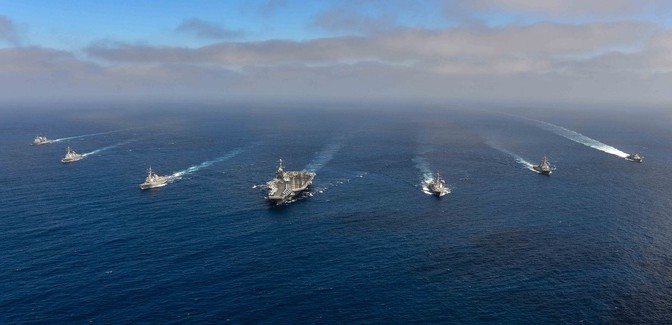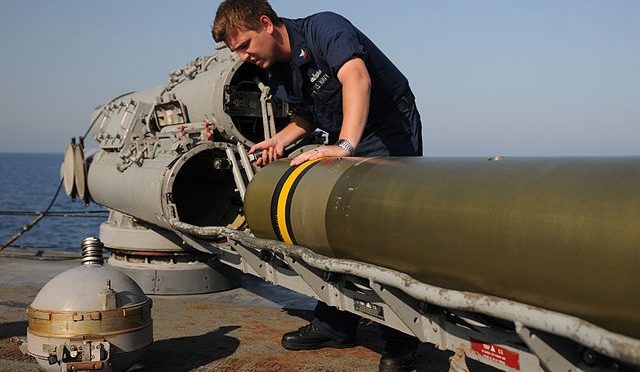By Captain Charlie Williams, U.S. Navy
Since the end of the Cold War, the Surface Navy has supported contingency operations around the globe, and done so exceptionally. Even so, some would argue that these operations have drawn us away from our basic warfighting skills – skills that have defined the United States as the world’s elite Surface Navy over the past 70 years.
In the area of Anti-Submarine Warfare (ASW), the Surface Warfare Officer (SWO) community must recapture that professionalism and intensity that drove us to become the premier ASW force in the 1970s and ‘80s — demonstrated time and again against the Soviet threat. We must dominate our Inner Screen while also correctly expanding our reach in the undersea domain.
Honed by years of experience and technological leaps, first in World War II and then again during the Cold War, ASW tactics and technology aligned with Anti-Surface Warfare (ASuW) as the focus of the destroyer force. With the collapse of the Soviet Union, the submarine threat diminished and the Surface Warfare community shifted our focus from ASW to support other emerging mission areas. The Surface force created VBSS boarding teams and manned crew-served weapons out of hide, and also honed our ability to execute Tomahawk strike missions to a fine and precision art form, while other nations instead determined to field a credible undersea force invested in capability and capacity.
As a result, our ASW proficiency suffered, as our ASW experience-based knowledge dwindled to the point where the Navy would have been challenged against a modern-day subsurface threat. We lost our foil and also our operational training opportunities that presented themselves every time our ships got underway. We no longer had the opportunity to train in real world track and trail events against a YANKEE, NOVEMBER, or VICTOR Class Submarine from the moment we left the sea buoy. Those opportunities were especially important in maintaining our complex skills required in the ASW arena, such as passive target motion analysis and active Convergence Zone (CZ) search and detection.
Today, with our renewed emphasis and shift to the Pacific, the Surface Navy must reclaim the ASW battle space if we are going to be successful in this new era.
The Evolving Threat
Recognizing the disruptive challenge submarines pose to our aircraft carriers and other high value assets, China, North Korea, and Iran have invested in a significant undersea capability and capacity. Real world events in the Western Pacific and in the Persian Gulf serve as regular examples as to why the United States must maintain the resolve to invest in our Surface Navy to maintain a preeminent ASW capability. From the Surface ASW perspective, quieter submarines, emerging submarine tactics, and advanced weapons are potential challenges to our Carrier Strike Group (CSG) and Expeditionary Strike Group (ESG) operational concepts – and to the Surface force’s ability to own the Inner Screen and defend the Strike Group. To meet this evolving threat and maintain our naval dominance — We Must Adapt.
Surface ASW Response
Recognizing the need to counter the emerging threat, the Surface Navy began using a method similar to the commercial sector allowing for timely and affordable modernization of our ASW capability with Commercial-Off-The-Shelf (COTS) hardware systems and Open Architecture (OA) software. We recognize our ASW operators require the best and most advanced tools available – and we have invested heavily in every aspect of that ASW kill chain.
Improvements include hardware and software upgrades to kinetic weapons such as the advanced Mk 54 Lightweight Torpedo that integrates with the MH-60R multi-mission helicopter; sensors, such as the Multi-Function Towed Array and the SPQ-9B Periscope Detection and Discrimination kit; advanced processing and display capabilities to increase operator recognition while leveraging the skill sets already developed in our Sailors; as well as the high fidelity trainers being delivered to the fleet today.
Today, 30 SQQ-89 A(V)15 ASW Combat Systems have reached the fleet and by 2020 there will be 64. That steady increase in capacity requires an equally steady application of financial resources, through which the Surface community has approached development of the ASW Combat System in a similar fashion to the continuous development and improvement of the AEGIS Combat System.
With the emergence of the Littoral Combat Ship (LCS) in the fleet, ASW operations will expand beyond the Arleigh Burke-class Destroyer (DDG) and Ticonderoga-class Cruiser (CG) in both an individual and additive manner. LCS, well suited to succeed in challenging littoral environments with its ASW Mission Package, will also support ASW escort missions. The combination of LCS and CRUDES ASW capabilities will significantly expand the reach of the ASW force, allowing it to operate in distinctly different environs in the open ocean and littorals while also enabling the DDG or CG to engage in other mission areas without sacrificing an ASW asset. The ASW capability realized by combining a Variable Depth Sonar with a Multi-Function Towed Array, plus the processing and display functionality of the A(V)15 system and the engagement capability of the onboard helo, provides a return on investment many times over.
Providing the US Navy with ASW capability takes more than hardware and software. Essential to successful ASW is the shipboard team that can exploit the capability being delivered as well as understand the environment affecting their system. This has always been true – but given the technologies being employed in today’s systems, and the threat we face at sea, our Sailors must be more technically and operationally savvy than ever before.
This requirement demands more time, both in port and at sea, to train in the skillsets unique to ASW. High fidelity unit level and shore based trainers delivered to the fleet facilitate this training, and add an element of at-sea realism to challenge even the most experienced operators. For the first time, the Navy can conduct high quality training both underway and in-port thru the A(V)15’s high fidelity Surface ASW Synthetic Trainer (SAST). SAST is also being integrated into a new shore based trainer to allow realistic watch team in-port training tailored to the specific skillset needed.
Understanding how the environment impacts your craft is critical to successful employment of your systems. Our schoolhouse training is being tailored to more effectively deliver basic and advanced operator and employment training. The Navy is also reinvigorating the Afloat Training Groups (ATG) with knowledgeable experts – they will be the key enablers, helping our young operators translate the schoolhouse training into operational experience with the necessary skills of this core competency.
ASW Command & Control and Today’s Inner Screen
An important element of owning the inner screen has been our partnering with other communities in the more distant ASW fight. The DESRON Sea Combat Commander embarked in the aircraft carrier (CVN) owns the Strike Group ASW problem, and they work that challenge in company with the Theater ASW Commander to coordinate what has become a broader definition of that inner screen’s boundary. Previously defined by the torpedo danger zone and our own acoustic detection ability, today’s inner screen has expanded based on the evolved submarine and longer range threats, and also a more diverse and more capable portfolio of our own CSG assets. This theater level of coordination requires a modernized set of tools including the Undersea Warfare Decision Support System (USW-DSS), and also a more agile and ready surface ASW force. Surface Navy’s continued investment in ASW is integral to furthering that coordination and enabling our success at sea.
Conclusion
Tactical ASW superiority is a critical enabler to maintain Forward Presence and Sea Control, and support Power Projection and Deterrence. This begins with owning the CSG’s Inner Screen, and enabling the broader ASW environment through coordinated operations with the Theater ASW Commander. Surface Warfare is perfectly postured to lead, plan and execute that Inner Screen, and use our capacity, on-station time, and command and control ability as enablers in the larger, theater ASW fight. Our investments in systems, training, and people have positioned us to reassert our mastery of this critical warfighting capability. The time is now for the Surface force to rededicate itself to this most central of missions. After all, the world’s most lethal power projection Navy cannot do its job if the water it operates in is threatened from below.
Captain Charlie Williams is the Deputy for Weapons and Sensors, Surface Warfare Directorate (N96). He commanded USS FIREBOLT (PC 10), USS STETHEM (DDG 63) and Destroyer Squadron FIFTEEN (CDS-15). As the Commodore in CDS-15, he served as the GEORGE WASHINGTON Strike Group Sea Combat Commander and Strike Force ASW Commander, and subsequently served as the Seventh Fleet Chief of Staff.




